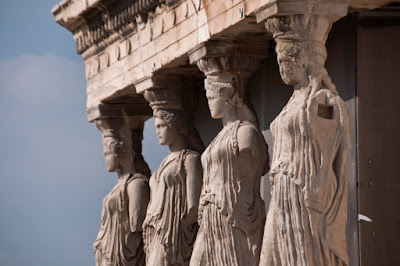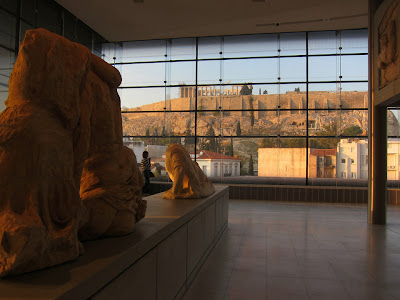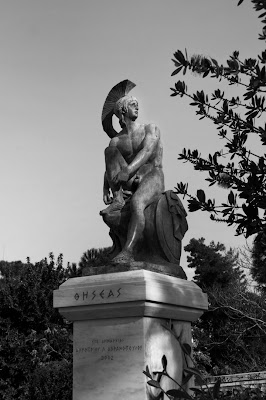My Life in Ruins, Part 1: Athens
Let me start by clearly stating that my trip to Greece and Turkey was in NOVEMBER of last year, and it has unfortunately taken me 7 months to find the time to start blogging about it! I just wanted to make that clear because delayed blog posts often lead to me bumping into people in the real world and hearing things like, “Didn’t you just get back from Greece?!”
So that said, I’ve been back for a while after a great trip. Having minored in Classical Civilization in college I’d wanted to go to Greece for years because, well, as Classical civilizations go it always seemed a lot cooler than Rome (the latter basically being a bunch of lazy, pasta-eating copycats). I originally added Turkey to the itinerary because there are just as many Classical sites in Western Turkey as there are in modern Greece or Rome—plus being the modern site of that ancient Greek nemesis, Troy, it seemed only fair to give equal time.
But it turns out that I wanted to see WAY too many things in only two short weeks, so the trip was basically Greece with a side of Turkey (sounds like a blue-plate special), the latter just consisting of a few days in Istanbul on the way home. And my time in Greece was largely a very nerdly tour of places that figure prominently into Greek history or mythology like Delphi, Olympia, Sparta, and Thermopylae—as well as the incomparably beautiful island of Santorini.
But of course it all started in Athens. Most people advised me to spend no more than a day in Athens. Some people even said to skip it all together. But there was no way in hell I was gonna visit Greece and not set foot on the Acropolis or see the treasures of the National Archaeological Museum! And while I will agree that it’s not the most beautiful city in the world, I found it perfectly lovely and well worth a couple of days to stroll and see the sights.
I checked into the historic Grand Bretagne Hotel, in the heart of Athens just across from the Parliament. They put me on the “butler floor”, meaning I had a butler at my service! But I wasn’t really sure what that meant so I never took advantage of it. After a night’s rest came my first bright and sunny Greek morning, and I headed straight for the Parthenon.
I guess it is one of those things that’s not exactly as you pictured it but even more exciting than you’d hoped. There’s nothing quite like climbing the steep embankments of the Acropolis along the same paths used by Plato, Pericles, and Aeschylus…suddenly, at the top, you walk through a gate and see the imposing columns of the Parthenon gleaming in the Attic sun.
Obviously the Parthenon has seen better days and is under constant restoration—but it’s held up better than the Greek economy. Hey-yo! (Sorry, couldn’t resist).
The haunting Caryatids staring over Athens as they have for 2,500 years:
Truth be told, the Caryatids are replicas, as the originals are inside the nearby Acropolis museum for protection from the elements. In the 20th Century, it became apparent that industrial pollution was accelerating the deterioration of works of art on the Acropolis. So this relatively new and amazing museum was designed to house the treasures of the Acropolis in full view of the Acropolis. Any elements removed from Acropolis buildings were replaced with replicas while the originals are safely on display inside.
It’s really well done. On the first floor, a glass floor allows you to walk over some ancient foundations. The floor slopes up to the second level to symbolize ascending the rock, and it is all filled with artifacts found on the Acropolis. The most impressive top floor houses the Parthenon marbles—two levels of friezes that wrapped around the entire Parthenon. They are situated exactly as they appeared on the building, with even the same cardinal orientation. Glass walls give you a spectacular view of the Parthenon itself and the natural light that fills the hall illuminates them exactly the same way so it is really an integrated experience.
Portions of the frieze are original, with reproductions of pieces that are in other museums around the world—including the famed Elgin Marbles in the British Museum, for which empty display cases make a poignant plea for their return, as the Greeks feel they were illegally taken.
The Theater of Dionysus is built into the slopes of the Acropolis; many of the great Greek plays had their premieres here.
Next I headed over to the Ancient Agora. The agora of any ancient Greek city represented its cultural, spiritual, political, artistic, and athletic heart.
The handsome Temple of Hephaestus is the best-preserved ancient Greek temple, still standing pretty much as it was built 2,500 years ago.
A dog sleeping in the Roman section, a later addition to the Agora that includes the Tower of the Winds:
And here’s a random statue of Theseus!
I always like to give a shout-out to my homies in any foreign land…
The next morning I walked across the street to the Parliament for the changing of the guard at the tomb of the Unknown Soldier.
Since there are only two guards it’s not exactly show stopping, but the goose-stepping is pretty entertaining, as are the pom-poms on their shoes. Their skirts famously contain exactly 400 pleats—one for each of the 400 years of Ottoman occupation.
Here’s a short video of their somewhat bizarre choreography—it’s a cross between marching, calisthenics, and Tai Chi (click to play)…
They’re not allowed to move at all under any circumstances so a soldier in a regular uniform stands by to groom them and ensure they are not harassed (other than the occasional humiliation of tourists taking photos with them).
Next stop, more ruins: The Temple of Olympian Zeus. Although little remains standing it was clearly one colossal temple.
The hairpin-shaped Panathenaic Stadium was originally built in 566 BC and rebuilt from the ruins in time to host the first modern Olympics in 1896. More recently it hosted the archery events in the 2004 Athens games.
Athens also has some impressive neoclassical buildings, including the Academy of Athens…
…the University of Athens…
…and the National Archaeological Museum:
Of course inside the museum are the real treasures, including the so-called “Mask of Agamemnon”, fine examples of uniquely highly-stylized Cycladic statues, and the famed Artemision Bronze—an impressive, hauntingly eyeless statue that was found at the bottom of the sea more than 2000 years after it sank in an ancient shipwreck. It is either Zeus or Poseidon, but we will probably never know because whatever he was holding—either a thunderbolt or a trident—was lost to the sea, along with his eyes.
My last night in Athens I headed up to the roof of my hotel to gaze one last time upon the floodlit Acropolis and Parliament.
The next day I picked up my rental car to head out on a road trip of the mainland and the Peloponnese, which I’ll save for my next entry. But in the meantime, a few things…first, as you know it is a time of some disarray in Greece, and I considered cancelling my trip due to the threat of strikes and riots. Once I was there, I never really saw any trouble. The opening hours of many attractions have been reduced because they’re broke but everything else was fine. There were often protestors outside parliament but they were peaceful, even jovial.
Plus it gave me the chance to see a local celebrity: Sausage the Athens Riot Dog! The Greeks don’t put stray dogs down. Instead, they tag them and ensure that they are cared for. As a result there are dogs all over the place.
When the protests in Syntagma Square have turned violent, most dogs hide. But Loukanikos (Greek for “Sausage”) has became famous for joining in the protests, always taking the protestors’ side by barking at the police and sneezing as he chases teargas canisters. I was fortunate enough to see him out one night. There was no riot, but he was busy ignoring the paparazzi while enjoying scraps of souvlaki from his adoring fans:
It was also the only time I’ve ever been I another country when their leader resigned. So long, George Papandreou.
Next up…Road tripping through Greek history and mythology. BUT BEFORE WE GO…A FEW PARTING SHOTS!
I gave some of my business to this gift shop, because how could I not?!
For some reason, Greece is the perfect place for some black and white photography. Here are some selects…
Also before we go...
My Uncle Sam Kestin passed away on May 14th at the age of 82. He was a talented photographer, equestrian, and horticulturalist. He was always genuinely interested in me and my activities, and I appreciated that. I will never see another orchid or smell the sweet scent of a pipe without thinking of him.
Next stop, Thermopylae and the Oracle of Delphi!





































































1 Comments:
Hey,
I know this is a year too late since you published the article, but i'm going to Greece this month and i'm really desperate to know whereabouts the Statue of Theseus is in Syntagma Sqaure.
Since you've posted a picture above, i'm guessing you successfully found him. Is there anyway you could help me out? Is he easy to find, or is he hidden somewhere >.<
Oh yeah, great blog by the way!
By Anonymous, at 7:23 AM
Anonymous, at 7:23 AM
Post a Comment
<< Home